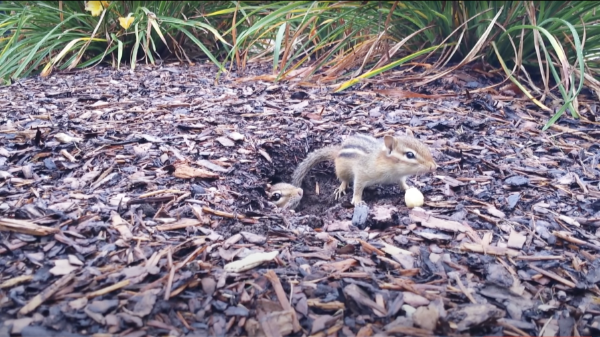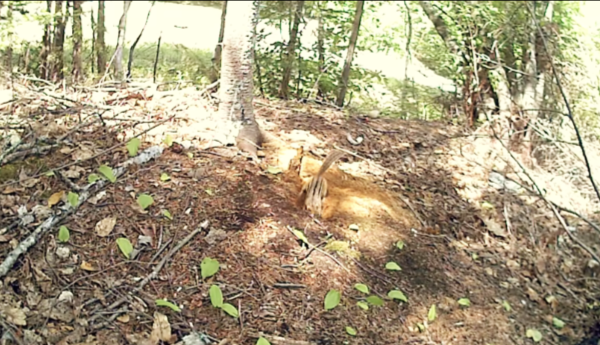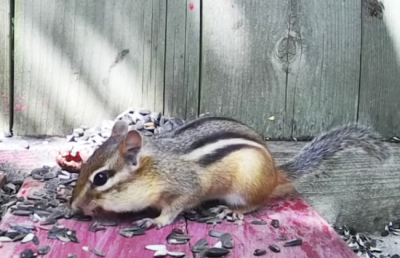Identification
Chipmunk Identification

There are several different ways you can identify the chipmunk, and not just by the way it looks. If you see a chipmunk, you can see its distinctive striped coat and understand what it is right away. What, though, if you only hear them, or find the droppings? This guide will help you determine whether it's chipmunks that are in the vicinity.
Sounds
Chipmunks are named after the very sound they make, a high pitched 'chipping' that's designed to communicate with other chipmunks nearby. They're sociable animals, so they will seek to communicate with others around them.
It has been determined that they make two kinds of noises, the chipping that they're known for, and a type of clucking noise that's lower. Some researchers believe that these sounds are designed to alert others to predators nearby. The chipping sound alerts others to predators on the ground, such as cats, foxes, or similar. The clucking, on the other hand, alerts others to predators in the sky, such as hawks.
It has been theorized that the behavior of chipping to other chipmunks is something that has been passed down the genetic line of chipmunks. Mother chipmunks tend to make their burrows near relative chipmunks, and so have an interest in alerting others to danger nearby.
These aren't the only reasons why chipmunks make these sounds, though. There is a multitude of different chipping sounds they can make at different pitches, which communicate all kinds of things.
Poop
A very good way of identifying chipmunks is by the poop they leave behind. Their droppings are often mistaken for mouse droppings, but it's worth noting that it's equally as toxic to humans, so you'll need to be careful if you do find it.
Typically, chipmunk poop is oblong in shape and about a quarter-inch longer than mouse droppings. If left for a longer period of time, they will become brittle and break if disturbed.
Typically, though, you're not going to see chipmunk poop unless they have got into your home. In a typical chipmunk burrow, they have several areas spread out over 2 – 4 meters around. This includes areas for sleeping with shredded leaves for bedding, and an area for food storage deeper underground so food doesn't spoil during the winter as they hibernate. This also includes a latrine and waste storage area, so typically you're not going to see the poop.
However, there are times that their poop will show up if they're making their homes around your house. They'll often do this because they can eat pests from your garden, so it's very easy for them to keep up their diet in your yard. Chipmunks sometimes choose to burrow under porches, sidewalks, and foundations. They can also sometimes even get into attics and basements. If this is the case, then you may find their poop out in the open.
Tracks
You can track chipmunks by their tracks, but it can be hard to do so. This is thanks to their diminutive size. As chipmunks are so small, it's very hard to find the tracks their small feet leave behind. If you're looking for tracks, you're better off looking for them in snow or in loose soil. These will hold the shape of the tracks best and make the job of identifying them easier.Again, it's very easy to mistake chipmunk tracks for mice tracks, as they look somewhat similar. Chipmunks have four toes on their front feet and five toes on their hind feet. What's interesting about the prints they leave is that the hind feet tracks are often seen in front of the front feet tracks. This is because as chipmunks move around, they move and bounce. This gives their tracks a distinctive 'gallop' pattern, so you'll be able to tell the difference between them and mice tracks should you need to.
Damage

If a chipmunk gets into your home or makes its burrow near or underneath your home, then you may see the damage. This is another good way to identify them, even if you don't see them in the act.
As they're a burrowing animal, you'll see that they create burrows under your land. If these burrows are extensive enough, they can cause the land to become unstable. If parts of your garden are beginning to sink, or holes have appeared, that's a sign that chipmunks have started to make their home underneath the ground.
If you're a gardener, then you'll see that they do cause damage to the plant life in your garden. They are omnivores and eat a wide range of things, so you'll see that several things will get eaten. They're particularly fond of eating roots and bulbs, so if your plants aren't growing they are most likely the reason why.
If you have a bird feeder in your garden, these are particularly attractive to chipmunks. If they found some seeds on the ground, that's maybe what appealed to them to move in in the first place. You may notice the seeds going missing faster, a sign that chipmunks have taken up residence.
One of the most dangerous things chipmunks can do is chew through electrical cabling in your yard. There's bound to be some underground, and chipmunks can easily come across it. As they're a part of the rodent family, they're known to chew on almost anything. Damage to your electrics is a sign there are chipmunks nearby.
Some homeowners decide to leave chipmunks be if they find them in their gardens. It's true that they're not as destructive as other animals, such as mice. Because of this, they're seen to be another species of wildlife that are welcome in the garden.
With all this information, you'll be able to identify a chipmunk even if you don't actually see the animal itself. Their sounds, poop, tracks, and the damage they cause all tell you a lot about them. Look carefully, and you'll be able to identify one before you ever see them in person.

